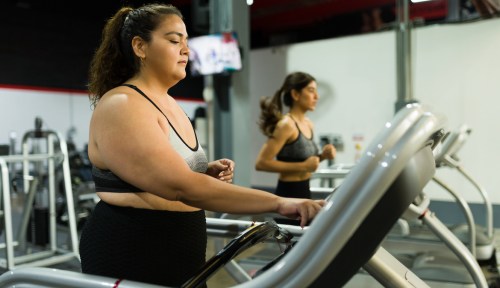This Knee-Strengthening Exercise Can Be Done on a Treadmill in 5 Minutes for Better Mobility and Less Pain
The TikTok tip about walking backwards for knee pain help seems to hold some merit, according to a physical therapist.

TikTok can be a fount of inspiration for everything from DIY home projects and recipes to useful hacks and workout tips. The only problem? Because both amateurs and professionals have equal access to sharing their “expertise” on the platform—and who knows how the algorithms help a video go viral—it can be tricky to separate out the helpful from the harmful.
Experts in This Article
So when we came across a backward walking treadmill workout by TikTok user @samanthafit_ish, whose real name is Samantha Kunes, we had to check out whether it could actually help with knee strength, as the video claims.
Does walking backwards really do anything to help your knees?
The good news: Physical therapist and founder of HolisticDPT, Eni Kadar, DPT, CHN, Cert. DN, says that Kunes might be onto something.
“A few of the most notable benefits of walking backwards on a treadmill (retrograde walking) are an increase in quad activation, and increased knee extension range of motion compared to forward walking,” says Dr. Kadar. “It can also assist with increasing lower extremity strength, functional mobility, and gait mechanics after an injury.”
In fact, one study found that, compared with walking forward, walking backwards on a treadmill caused more significant improvements in knee pain and quadriceps strength after six weeks in people with osteoarthritis.
Dr. Kadar says that the differences in the biomechanics are what makes walking backwards more beneficial to the knees. “With forwards walking, you are advancing one leg at a time, landing on your heel and rolling off your toe. During the swing phase of gait, your knee is bent and your toes are lifted up towards your shin,” she says. To control these motions, the quadriceps and hip flexors contract concentrically (shortening) to advance the leg and the glutes and hamstrings contract eccentrically (lengthening) to control the landing.
However, these muscle contractions can potentially elicit knee pain.
“The concentric contraction of the quads and hip flexors, along with immobility of the hamstrings, often is what causes knee discomfort for people due to muscle imbalances and undue pressure on the structures,” explains Dr. Kadar.
But changing the movement direction changes the muscle activation. “In retrograde walking, you are landing on your toe first and then rolling off your heel,” she says. “Retrograde walking requires more hip and knee extension to occur during the stance phase and more knee flexion when you reach back to take steps.”
When you walk backwards, the same muscle groups are involved, but their actions are reversed: The quadriceps and hip flexors lengthen, while the glutes and hamstrings shorten. This can put less stress and compressive force on the knees.
So how does this decrease knee pain?
Dr. Kadar says that many people with knee pain have limited range of motion in the knees, which can compromise normal walking patterns and can cause discomfort.
Backward walking can help restore some mobility. “The repetitive and low-intensity nature of walking backwards can improve knee extension for people without putting a lot of force or stress through the joint so it can be more comfortable,” Dr. Kadar says. “When you are walking backwards, you are required to extend your knee more than if you were going forwards. The quadriceps is responsible for extension of the knee and strength of this muscle is key to manage and prevent knee pain, especially in populations with osteoarthritis.”
She believes that backwards walking on a treadmill can be a great addition to other strengthening programs to improve knee mobility, strength, and function. Plus, she says it can improve hamstring flexibility, a common problem among those with knee pain.
How to safely walk backwards on a treadmill
You can incorporate backwards walking into your workouts as a warmup, cooldown, or even a standalone activity. But it might feel awkward at first. Dr. Kadar shares a few tips on how to do it safely:
- 1.Start with a slower speed (1 to 2 mph) and hold onto the handrails for balance. You can let them go once you get more comfortable.
- 2.Use the safety key by attaching the lanyard to your shirt at hip height. This will automatically stop the belt if you get too far from the console.
- 3.Begin with five to 10 minutes and gradually build up as your endurance improves.
- 4.Think of reaching back with your leg, landing on your toe and rolling through to your heel before picking up your other leg.
- 5.Focus on taking even steps, keeping your step length the same on both sides.
- 6.Engage your core muscles and stay as upright as possible, avoiding the tendency to lean forwards.
- 7.Add a slight incline as you get stronger to reap additional benefits.
- 8.If you have poor balance or are unsure, ask for help from a qualified trainer to avoid injury.
But don’t forget forward walking, or other strength workouts. “We don’t walk around backwards throughout the day (hopefully)!” Dr. Kadar notes. “Reverse walking is a useful tool, but I don’t consider it a replacement to a properly structured strengthening program. And always listen to your body and don’t push through anything that doesn’t feel right.”
Sign Up for Our Daily Newsletter
Get all the latest in wellness, trends, food, fitness, beauty, and more delivered right to your inbox.
Got it, you've been added to our email list.










